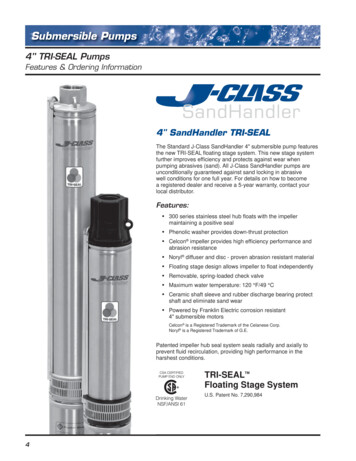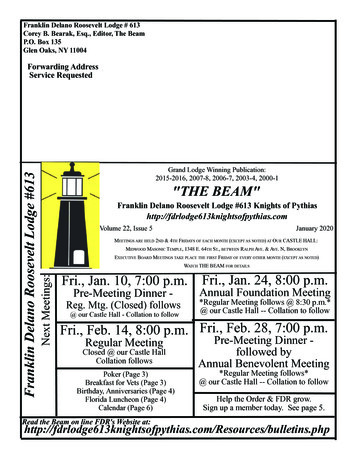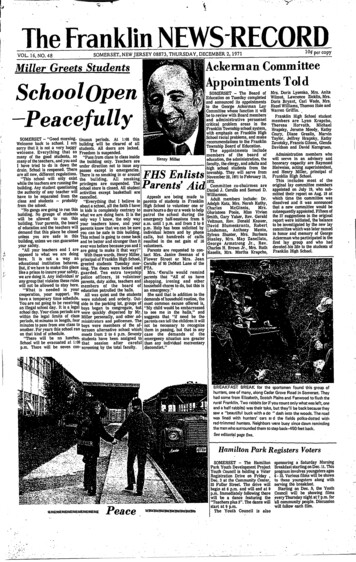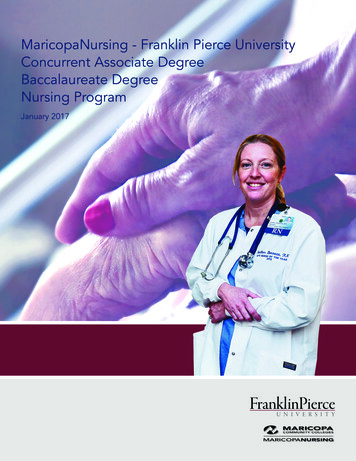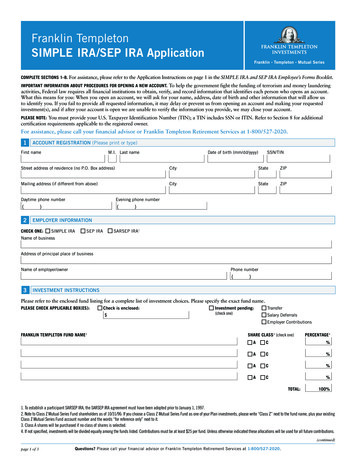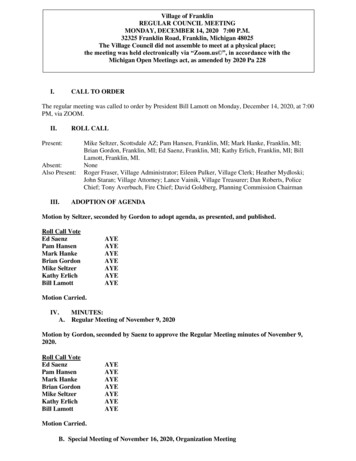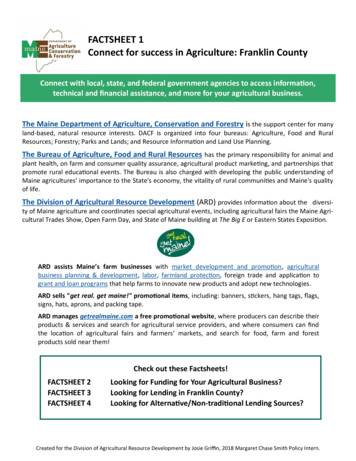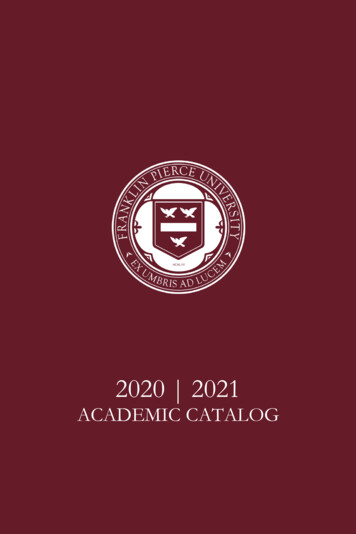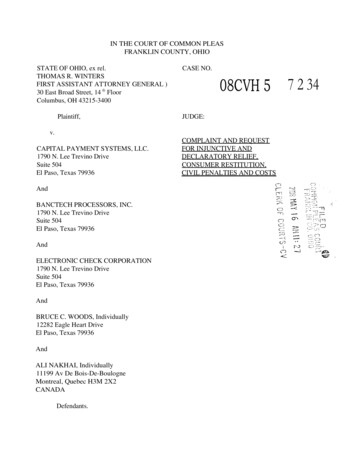
Transcription
IN THE COURT OF COMMON PLEASFRANKLIN COUNTY, OHIOSTATE OF OHIO, ex rel.THOMAS R. WINTERSFIRST ASSISTANT ATTORNEY GENERAL )30 East Broad Street, 14 th FloorColumbus, OH 43215-3400Plaintiff,CASE NO.08CVH 5JUDGE:v.CAPITAL PAYMENT SYSTEMS, LLC.1790 N. Lee Trevino DriveSuite 504El Paso, Texas 79936AndBANCTECH PROCESSORS, INC.1790 N. Lee Trevino DriveSuite 504El Paso, Texas 79936AndELECTRONIC CHECK CORPORATION1790 N. Lee Trevino DriveSuite 504El Paso, Texas 79936AndBRUCE C. WOODS, Individually12282 Eagle Heart DriveEl Paso, Texas 79936AndALI NAKHAI, Individually11199 Av De Bois-De-BoulogneMontreal, Quebec H3M 2X2CANADADefendants.COMPLAINT AND REQUESTFOR INJUNCTIVE ANDDECLARATORY RELIEF,CONSUMER RESTITUTION,CIVIL PENALTIES AND COSTS7 2 34
JURISDICTION AND VENUE1. Plaintiff, State of Ohio, by and through the First Assistant Attorney General ofOhio, Thomas R. Winters, having reasonable cause to believe that violations of Ohio'sconsumer laws have occurred, brings this action in the public interest and on behalf of theState of Ohio under the authority vested in him by the Ohio Consumer Sales Practices Act(hereinafter, "CSPA"), R.C. 1345.01 et seq. and R.C. 109.87. Plaintiff seeks injunctive anddeclaratory relief, consumer restitution, civil penalties, attorney fees, costs, and other appropriaterelief.2. The actions of Defendants, hereinafter described, have occurred in the State of Ohio,Franklin County, and other Ohio counties, and as set forth below, are in violation of the CSPA,R.C. 1345.01 et seq. and R.C. 109.87.3. Jurisdiction over the subject matter of this action lies with this Court pursuant to R.C.1354.04 of the CSPA and R.C. 109.87(D)(1).4. This Court has venue to hear this case pursuant to Ohio Civ. R. 3(B)(1)-(3), in thatmany of the transactions complained of herein, and out of which this action arose, occurred inFranklin County.DEFENDANTS5. Defendant Capital Payment Systems, LLC., (hereinafter, "CPS"), is a limited liabilitycompany registered with the Delaware Secretary of State's Office. The principal office for CPSis located at 1790 N. Lee Trevino Drive, Suite 504, El Paso, Texas 79936.6. Defendant BancTech Processors, Inc., (hereinafter, "BTS"), is a registeredcorporation with the Texas Secretary of State. The principal office for BTS is located at 1790 N.Lee Trevino Drive, Suite 504, El Paso, Texas 79936.2
7. Defendant Electronic Check Corporation (hereinafter, "ECC") is a registeredcorporation with Texas Secretary of State. The principal office for ECC is located at 1790 N.Lee Trevino Drive, Suite 504, El Paso, Texas 799368. Defendants Capital Payment Systems, BancTech Processors and Electronic CheckCorporation are not registered as foreign corporations with the Ohio Secretary of Statepursuant to R.C. 1703.01.9. Defendant Ali Nakhai (hereinafter, "Nakhai"), an individual, is the ManagingMember of CPS. Nakhai is a Canadian citizen residing at 11199 Av De Bois-De-Boulogne,Montreal; Quebec Canada H3M 2X2.10. Defendant Bruce Woods (hereinafter, "Woods"), an individnal, is the GeneralManager of Defendant CPS, the President and Director of Defendant BTP and the )0( ofDefendant Electronic Check Corporation.11. At all relevant times, Defendants Ali Nakhai and Bruce Woods have had fulldominion and control of Defendant CPS by controlling CPS's policies, procedures and clientselection. Defendants Ali Nakhai and Bruce Woods have committed, allowed, directed, ratifiedor otherwise caused the unlawful acts and practices explained below to occur.12. At all relevant times, Defendant Bruce Woods had full dominion and control ofDefendant BTP and ECC by controlling the policies, procedures and client selection ofDefendants BTP and ECC. Defendant Bruce Woods has committed, allowed, directed, ratifiedor otherwise caused the unlawful acts and practices explained below to occur.13. Defendants are "suppliers" as that term is defined in R.C. 1345.01(C), as Defendantswere, at all relevant times, engaged in and/or effected consumer transactions by preparing andprocessing bank debits to consumer bank accounts on behalf of their clients. As "suppliers,"3
Defendants effected consumer transactions for "individuals" in Franklin County and othercounties in the State of Ohio and throughout the country that were primarily personal, family orhousehold within the meaning specified in R.C. 13450.1(A) and (D).BACKGROUNDA. The International Problem of Predatory Telemarketing Fraud14. The Unites States Congress has estimated that telemarketing fraud costs Americansnearly 40 billion every year.15. Perpetrators of telemarketing fraud use the telephone to deprive victims of theirmoney by using manipulation and misrepresentations to persuade victims to part with funds orother personal information with which the telemarketer accesses the victims' financial resourceswithout authorization.16. The telemarketing fraud industry is highly sophisticated and very mobile. They oftenuse "boiler room" call centers which are equipped with a large number of telephone lines. Theyare often located in foreign countries such as, Canada, India and the West Indies.17. In boiler room call centers, telemarketers are trained to identify likely victims. Theyare provided with sales scripts that filled with false promises, misleading information and highpressure sales techniques.18. Fraudulent telemarketers and their accomplices often trade in lists of prospectivevictims, including repeat victims who are likely to be victimized with additional schemes. Often,those traded lists include not only the identity and contact information for victims, but alsopersonal financial information such as bank or credit card account numbers.19. Canada has been identified by the United States government as a country withsubstantial fraudulent telemarketing activity directed at victims in the United States. In 1997,4
United States President Clinton and Canadian Prime Minister Chretien directed officials toexamine ways to counter the serious and growing problem of Canada-United Statestelemarketing fraud. Montreal, Vancouver and Toronto were identified as Canadian cities withparticularly active fraudulent telemarketing operations.20. According to the National Consumer League's National Fraud Information Center,the top locations for fraudulent telemarketers in the first calendar quarter of 2005 are countriesoutside the United States, including Canada.B. Payment Processors are Essential Participants in Telemarketing Fraud21. According to the National Consumer League's National Fraud Information Center,bank debits were the second most common method of payment by victims to fraudulent(telemarketers.22. A telemarketer who obtains information on a victim's bank account can arrange tohave that account debited, whether or not the victim actually agreed to have his or her accountcharged.23. The success of telemarketing fraud, and in particular cross-border telemarketingfraud, is dependent upon entities known as third-party payment processors (hereinafter referredto as "payment processor") to facilitate the banking procedures by which money is taken fromvictims' bank accounts and transferred to the perpetrators of fraud.24. The schemes require telemarketers, also known as merchants or originators, tocontract with payment processors, like the Defendants, to collect and transmit money.25. A payment processor establishes an account with a bank. The telemarketer providesthe payment processor with the consumers' bank account information and other information,such as the amount of the purported "sale."5
26. The payment processors use the consumers' information to debit the consumers'account through one of two methods, a remotely created check (sometimes also known as a"demand draft") or an Automated Clearing House (hereinafter, "ACH") debit, (collectivelyreferred to as "bank debits".)27. An ACH debit refers to an electronic withdrawal of funds, without the use of anypaper check, from a consumer's bank account. ACH transactions are subject to the interbankrules of the National Automated Clearing House Association (hereinafter, "NACHA"). Thoserules prohibit processing ACH transactions on behalf of businesses engaged in outboundtelemarketing calls to consumers with whom they have no existing business relationship. As aresult of NACHA's prohibition on using ACH transaction with outbound telemarketingsolicitations to persons with which they have no existing business relationship, manytelemarketers have migrated to the use of remotely created checks to debit consumer accounts.28. By contrast, a remotely created check ("RCC") is an unsigned paper check. In placeof a signature, an RCC will state "Authorized by Account Holder," "Signature Not Required," or"This payment has been authorized by the above-named depositor and is guaranteed by thepayee" or something similar. RCCs can be printed using readily available computer hardwareand software and are handled (and optically scanned) by the banking system in the United Statesas normal personal checks.29. Both ACH debits and demand drafts can be initiated using two pieces of information(other than the amount of the funds to be debited): the number of the drawee's bank account,and the routing number that identifies the bank where the account is located. These twonumbers, sometimes referred to as the "MICR [Magnetic Ink Character Recognition] Code,"appear at the bottom of regular bank checks.6
30. The draft or debit is payable to the telemarketer, but is deposited into the bankaccount of the payment processor. Typically, a payment processor will then forward the fundsreceived as a result of the bank transaction to the telemarketer, less a fee for the paymentprocessor.31. When a large number of bank debits—whether ACH or demand draft—are"returned" by account holders for a credit on similar transactions—that typically indicates aproblem with the transactions between the merchant and its customer.32. A bank draft or ACH debit "return" refers to a transaction refused or reversed bythe payor's bank due to any number of reasons, such as the transaction was not authorized bythe payor, invalid bank account number, insufficient funds in the payor's account, the accountwas closed, or other similar reasons. Return rates that deviate substantially from normativerates are often indicia of fraud. In many cases, high returns rates reflect a lack of payorauthorization for bank drafts.33. Specifically, a high "return rate" (the percentage of attempted debits that arereturned out of the total number of attempted debits) for a specific merchant commonlyindicates the lack of consumer authorization, either where the consumer never authorized thedebit, or where the consumer authorized the debit, but the authorization is based on deceptivemisrepresentations or omissions about the offer that is the subject of the transaction.34. For ACH transactions, NACHA has rules that set forth more than sixty (60)different "return reason codes" that consumers' banks must use to classify the reason they arereturning the ACH transactions. 2006 ACH Rules, pp. OR 92-98. For example, the currentreturn code RIO stands for "consumer advises not authorized."7
35. NACHA publishes on a quarterly basis detailed statistics on average return ratesexperienced by the ACH network as a whole ("industry average return rates"). Thesestatistics include both the total return rates (the percentage of all ACH transactions that arereturned out of the total number of attempted debits, regardless of the return reason providedby the consumers' banks), as well as return rates for specific return reasons (the percentage ofACH transactions that are returned for identified reasons under certain return codes, such as"R02"- "account closed", out of the total number of attempted debits.)36. NACHA's statistics on industry average return rates include not only return ratesfor all ACH transactions (averaged across all type of ACH transactions), but also for certainspecific types of ACH transactions, such as "PPD" transactions ("pre-arranged payment anddeposit entry"), "WEB" transactions (Internet-initiated transactions), and "TEL" transactions(one-time telephone-initiated transactions to consumers with whom the merchant had anexisting relationship). These detailed industry average return rates provide multiple baselinemeasures with which to compare and monitor merchant return rates.37. For example, out of the four quarters in 2005, the highest quarterly industryaverage total return rate for all ACH debit transactions was 2.3 percent, for PPD transactionswas 2.96 percent, and for WEB transactions was 1.95 percent. During that same time period,for the specific return code R10 (customer advises not authorized), the highest quarterlyindustry average return rate for all ACH transactions was 0.02 percent, for PPD transactionswas 0.04 percent, and for WEB transactions was 0.07 percent. NACHA Risk ManagementNews, Winter 2006, Volume 2, Issue 1; NACHA Risk Management News, December 2005,Volume 1, Issue 6.8
38. NACHA rules and guidelines emphasize the responsibility of all ACH participants,including payment processors such as the Defendants, to monitor merchant return rates andother suspicious activity to detect and prevent fraud in the ACH Network.39. In contrast to ACH transactions, there is no entity within the banking industry,such as NACHA, that collects industry average return rates for RCCs. RCCs are not coded ortracked separately from regular bank checks through the check-clearing system.40. However, with respect to bank checks (which include RCCs and other types ofchecks), the Federal Reserve Board has published a Payment Study, in which it estimates thatthe average rate for checks returned as uncollected in the United States is one-half of onepercent. See Federal Reserve Bank, Trends in the use of Payment Instruments in the UnitedStates (2005) at 194, A. 112 1 .41. Unlike in the ACH network, in the check-clearing system, there are no industryaverage return rate statistics available for specific return reasons, such as "unauthorized" or"invalid" account numbers. Also unlike the ACH network, the return of checks (includingboth RCCs and other types of checks) is not subject to a uniform national body of rulesgoverning the classifications employed by different banks to characterize the return reasonsfor checks. Some of the return reason classifications used for checks are similar to those usedby the ACH Network, while others are not.Available at pring05payment.pdf.9
42. Despite the absence of a uniform classification system used by banks tocharacterize the return reason for bank checks (which includes RCCs), banks and paymentprocessors can monitor merchant return rates and other signs of suspicious activity to detectand prevent fraud through the banking system. For example, they can monitor the total returnrates of their clients' RCC transactions, analyze the percentage of returned RCCs that arereturned for specific reasons, compare their clients' return rates to industry average returnrates for other existing comparable payment mechanisms, and watch closely for other signs ofsuspicious or fraudulent merchant activity.43. The Bank Secrecy Act/Anti-Money Laundering Examination Manual(2006),published by the Federal Reserve and Office of the Controller of the Currency, includes an entirechapter devoted to "Third Party Payment Processors." It highlights return rates as a keyindicator of illicit transactions by third party payment processors.FACTSProcessing by CPS, BTP and ECC44. Many, if not all, of the Defendants' telemarketing clients are "telephone solicitors"as each client is a "person" that engages in "telephone solicitation" directly or through one ormore "salespersons" either from a location in this state, or from a location outside this state topersons in this state, as those terms are defined in R.C. 4719.01.45. At all times relevant to this lawsuit, Defendants acted as payment processors thattook MICR Code and related data from its clients, in electronic file format and processedbank debits so that the clients' customers would have money debited from their bankaccounts.10
46. From approximately January of 2006 through April of 2007, Defendants CPS, AliNakhai and Bruce Woods processed over 3,000 payments from the bank accounts of Ohioconsumers resulting transactions totaling over 1,034,229.0047. From approximately November of 2006 through June of 2007, Defendants BTPand Bruce Woods processed over 190 payments from the bank accounts of Ohio consumersresulting in transactions totaling over 62,000.48. Defendants CPS, Bruce Woods and Ali Nakhai directly or indirectly maintained,accounts with financial institutions located in the United States through which theyprovided payment processing services to their telemarketing clients. Those financialinstitutions included Fifth Third Bank and Bank of Texas.49. Defendants BTP, ECC and Bruce Woods directly or indirectly maintainedmerchant accounts with financial institutions located in the United States through which theyprovided payment processing services to their telemarketing clients. Those financialinstitutions included Inter National Bank, City Bank of Texas, Bank of Kentucky, and Bankof Texas.50. Defendants' clients obtained the MICR Code from consumers, sometimeslegitimately, sometimes by deception or without authorization, and transmitted that data inbatches to Defendants, for the purpose of initiating debits from the consumers' bank accounts.51. Defendants provided their telemarketing clients payment processing serviceswhich grant the telemarketers instantaneous access to consumers' bank accounts, from whichwithdrawals of hundreds of dollars at a time are made, often without the consumer'sauthorization and sometimes without the consumer's realization. Even when the withdrawal11
is authorized by the consumer, the authorization is typically induced by a misleading salespitch.52. Defendants exercised limited due diligence in screening and selecting the companieson whose behalf it processed bank debits.53. Many of the Defendants' clients were telemarketers whose methods of doingbusiness raised serious questions of legality.54. Defendants retain as payment for services a portion of the money it receives inconnection with fraudulent telemarketing schemes.55. Many of Defendants' client telemarketers were located in Montreal, a city knownto be a particularly active area for telemarketing fraud perpetrators.56. Typically, when a telemarketer applied to the Defendants for payment processingservices, they provided copies of the telemarketers' sales script and/or verification scripts.Inmany cases, Defendants agreed to process payments for merchants who submitted sales andverification scripts that contained inconsistent or contradictory representations about theproduct or service marketed or illustrated deceptive sales techniques.57. Defendants were in the possession of sales scripts purportedly used by some oftheir telemarketing clients that violated the Federal Telemarketing Sales Rule in that theyfailed to disclose truthfully, in a clear and conspicuous manner, the identity of the seller,nature of the goods or services, any material limitations or restrictions of use for the goods orservices and the seller's refund policy.58. Defendants were in the possession of sales scripts purportedly used by some oftheir telemarketing clients that contained violations the Federal Telemarketing Sales Rule in12
that they misrepresented material aspects of the performance, nature or characteristics of thegoods or services they proposed to sell.59. Defendant CPS, Ali Nakhai and Bruce Woods were in possession of sales scriptscontaining the following offers:: Woldram & Hart, LTD, doing business as Protect First USA:: This companypurports to be selling a Privacy Program that "makes the process of stopping allunwanted tel
"returned" by account holders for a credit on similar transactions—that typically indicates a problem with the transactions between the merchant and its customer. 32. A bank draft or ACH debit "return" refers to a transaction refused or reversed by the payor's bank due to any number

